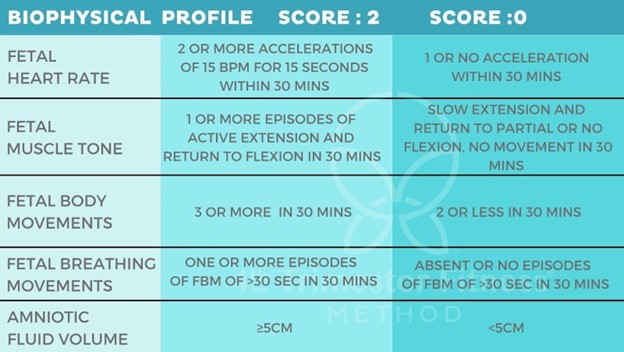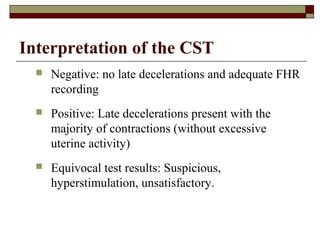A nurse is reviewing the findings of a biophysical profile (BPP) for a client who is at 40 weeks of gestation.
The BPP score is 6 out of 10 points.
Which of the following components are included in this score? (Select all that apply.)
Fetal breathing movement
Fetal tone
Reactive fetal heart rate
Amniotic fluid volume
Fetal position
Correct Answer : A,B,C,D
The correct answer is choice A, B, C and D. These are the four components of a biophysical profile (BPP) that are scored as 2 (normal) or 0 (abnormal) based on ultrasound examination. The fifth component is the nonstress test (NST) that measures the fetal heart rate reactivity. A total score of 8 or 10 is normal, 6 is equivocal, and 4 or less is abnormal.
Choice E is wrong because fetal position is not a part of the BPP score. Fetal position is determined by ultrasound but it does not affect the score.

Normal ranges for each component are:
• Fetal breathing movement: One or more episodes of fetal breathing lasting at least 30 seconds within 30 minutes.
• Fetal tone: One or more episodes of active extension and flexion of a fetal extremity or opening and closing of the hand within 30 minutes.
• Reactive fetal heart rate: Two or more fetal heart rate accelerations that peak at least 15 beats per minute above the baseline and last at least 15 seconds from baseline to baseline during 20 minutes of observation.
• Amniotic fluid volume: A single deepest vertical pocket of amniotic fluid that measures at least 2 centimeters.
• Gross body movement: Three or more discrete body or limb movements within 30 minutes.
Nursing Test Bank
Naxlex Comprehensive Predictor Exams
Related Questions
Correct Answer is B
Explanation
NST is less time-consuming and more comfortable than CST.This is because NST does not require any external stimulation of the uterus, while CST involves giving oxytocin to induce contractions.NST also does not pose any risk of preterm labor or fetal distress, which are possible complications of CST.
Choice A is wrong because NST does not provide more information about fetal status than CST.In fact, CST can detect fetal hypoxia more accurately than NST.
Choice C is wrong because NST does not have fewer contraindications than CST.Both tests have similar contraindications, such as placenta previa, multiple gestation, and previous cesarean section.
Choice D is wrong because NST does not have higher sensitivity and specificity than CST.
Sensitivity refers to the ability of a test to correctly identify positive cases, while specificity refers to the ability of a test to correctly identify negative cases.
NST has a high sensitivity but a low specificity, meaning it can detect most fetuses with hypoxia but also has many false positives.CST has a low sensitivity but a high specificity, meaning it can miss some fetuses with hypoxia but also has few false negatives.
Correct Answer is B
Explanation
Negative or normal.This means that there are no late decelerations of the fetal heart rate (FHR) after three contractions in a 10-minute period, which indicates that the baby can tolerate the stress of labor contractions.
Choice A is wrong because positive or abnormal results mean that there are late decelerations of the FHR after three contractions in a 10-minute period, which suggests that the baby may be at risk of hypoxia or injury during labor.
Choice C is wrong because equivocal or suspicious results mean that there are either variable decelerations or late decelerations after fewer than half of the contractions, which require further testing or monitoring.
Choice D is wrong because unsatisfactory or incomplete results mean that there are either fewer than three contractions in a 10-minute period or poor quality of the FHR tracing, which prevent an accurate interpretation of the test.

Whether you are a student looking to ace your exams or a practicing nurse seeking to enhance your expertise , our nursing education contents will empower you with the confidence and competence to make a difference in the lives of patients and become a respected leader in the healthcare field.
Visit Naxlex, invest in your future and unlock endless possibilities with our unparalleled nursing education contents today
Report Wrong Answer on the Current Question
Do you disagree with the answer? If yes, what is your expected answer? Explain.
Kindly be descriptive with the issue you are facing.
